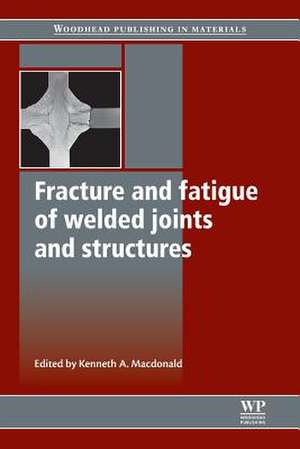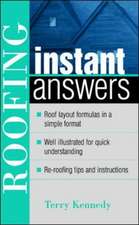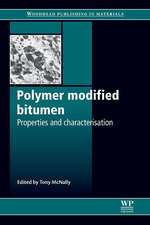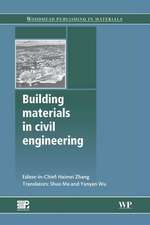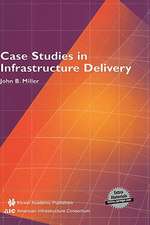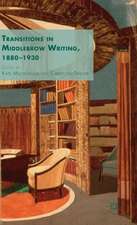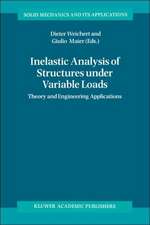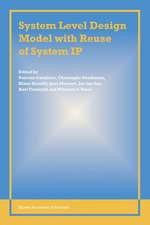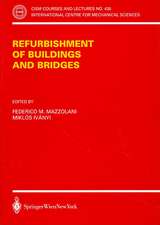Fracture and Fatigue of Welded Joints and Structures: Woodhead Publishing Series in Welding and Other Joining Technologies
Editat de K Macdonalden Limba Engleză Paperback – 18 aug 2016
- Analyses the processes and causes of fracture and fatigue, focusing predicting and minimising the failure of welded joints in the design process
- Assesses the fracture of welded joints and structure featuring constraint-based fracture mechanics for predicting joint failure
- Explores specific considerations in fatigue analysis including the assessment of local stresses in welded joints and fatigue design rules for welded structures
Preț: 870.59 lei
Preț vechi: 956.69 lei
-9% Nou
Puncte Express: 1306
Preț estimativ în valută:
166.64€ • 181.07$ • 140.07£
166.64€ • 181.07$ • 140.07£
Carte tipărită la comandă
Livrare economică 15-29 aprilie
Preluare comenzi: 021 569.72.76
Specificații
ISBN-13: 9780081017029
ISBN-10: 0081017022
Pagini: 360
Dimensiuni: 156 x 234 x 19 mm
Greutate: 0.49 kg
Editura: ELSEVIER SCIENCE
Seria Woodhead Publishing Series in Welding and Other Joining Technologies
ISBN-10: 0081017022
Pagini: 360
Dimensiuni: 156 x 234 x 19 mm
Greutate: 0.49 kg
Editura: ELSEVIER SCIENCE
Seria Woodhead Publishing Series in Welding and Other Joining Technologies
Cuprins
Contributor contact details
Preface
Introduction
Introduction
Linear elastic fracture mechanics
Fatigue
Layout
Part I: Analysing fracture of welded joints and structures
Chapter 1: Constraint-based fracture mechanics in predicting the failure of welded joints
Abstract:
1.1 Introduction to constraint-based elastic-plastic fracture mechanics
1.2 Constraint parameters
1.3 Tabulation of Q-solutions
1.4 Development of a failure assessment diagram (FAD) approach to incorporate constraint
1.5 Effect of weld mismatch on crack tip constraint
1.6 Full field (local approach) analysis for fracture assessment
1.7 Conclusion
Chapter 2: Constraint fracture mechanics: test methods
Abstract:
2.1 Introduction
2.2 High strains
2.3 Two-parameter fracture mechanics
2.4 Development of the single edge notch tension (SENT) test
2.5 Standardising the single edge notch tension (SENT) test
2.6 Conclusions
2.8 Appendix: Codes and standards
2.9 Nomenclature
Chapter 3: Fracture assessment methods for welded structures
Abstract:
3.1 Introduction
3.2 Development of engineering critical assessment (ECA) methods
3.3 The failure assessment diagram (FAD) concept
3.4 Specific engineering critical assessment (ECA) methods: R6
3.5 Specific engineering critical assessment (ECA) methods: BS 7910/PD6493
3.6 Specific engineering critical assessment (ECA) methods: Structural Integrity Procedures for European Industry (SINTAP)/European Fitness- for-service Network (FITNET)
3.7 Specific engineering critical assessment (ECA) methods: American Petroleum Institute (API)/ American Society for Mechanical Enginners (ASME)
3.8 Future trends
Chapter 4: The use of fracture mechanics in the fatigue analysis of welded joints
Abstract:
4.1 Introduction to fracture mechanics
4.2 Technical application of fracture mechanics
4.3 Fatigue assessment of welded joints using fracture mechanics
4.4 Examples of practical application
4.5 Conclusions
Part II: Analysing fatigue of welded joints and structures
Chapter 5: Fatigue strength assessment of local stresses in welded joints
Abstract:
5.1 Introduction
5.2 Types of stress
5.3 Factors affecting the fatigue strength
5.4 Fatigue strength assessment
5.5 Conclusions
Chapter 6: Improving weld class systems in assessing the fatigue life of different welded joint designs
Abstract:
6.1 Introduction
6.2 Historic view
6.3 Weld class system ISO 5817
6.4 Weld class systems at Volvo
6.5 A consistent and objective weld class system
6.6 Discussion
6.7 Conclusions
6.8 Future trends
6.9 Sources of further information and advice
Chapter 7: Fatigue design rules for welded structures
Abstract:
7.1 Introduction
7.2 Key features of welded joints influencing fatigue
7.3 Fatigue crack propagation
7.4 Design rules
7.5 Future developments in the application of fatigue rules
7.6 Conclusions
7.8 Appendix: fatigue design codes and standards
Chapter 8: Fatigue assessment methods for variable amplitude loading of welded structures
Abstract:
8.1 Introduction
8.2 Fatigue damage and assessment for variable amplitude loading
8.3 Variable amplitude fatigue testing
8.4 Future trends
8.5 Source of further information and advice
Chapter 9: Reliability aspects in fatigue design of welded structures using selected local approaches: the example of K-nodes for offshore constructions
Abstract:
9.1 Introduction
9.2 Selected decisive design parameters
9.3 Selected design concepts by the example of K-nodes
9.4 Conclusions
Chapter 10: Assessing residual stresses in predicting the service life of welded structures
Abstract:
10.1 Introduction
10.2 Origins and types of stress
10.3 Modification of stresses after welding
10.4 Measurement
10.5 Conclusions
10.6 Acknowledgements
Chapter 11: Fatigue strength improvement methods
Abstract:
11.1 Introduction
11.2 Fatigue strength of welded joints
11.3 Increasing the fatigue strength by improved design
11.4 Improvements obtained by special plate material, filler materials or welding methods
11.5 Special welding methods
11.6 Post‐weld improvement methods
11.7 Future trends
11.8 Conclusions
Index
Preface
Introduction
Introduction
Linear elastic fracture mechanics
Fatigue
Layout
Part I: Analysing fracture of welded joints and structures
Chapter 1: Constraint-based fracture mechanics in predicting the failure of welded joints
Abstract:
1.1 Introduction to constraint-based elastic-plastic fracture mechanics
1.2 Constraint parameters
1.3 Tabulation of Q-solutions
1.4 Development of a failure assessment diagram (FAD) approach to incorporate constraint
1.5 Effect of weld mismatch on crack tip constraint
1.6 Full field (local approach) analysis for fracture assessment
1.7 Conclusion
Chapter 2: Constraint fracture mechanics: test methods
Abstract:
2.1 Introduction
2.2 High strains
2.3 Two-parameter fracture mechanics
2.4 Development of the single edge notch tension (SENT) test
2.5 Standardising the single edge notch tension (SENT) test
2.6 Conclusions
2.8 Appendix: Codes and standards
2.9 Nomenclature
Chapter 3: Fracture assessment methods for welded structures
Abstract:
3.1 Introduction
3.2 Development of engineering critical assessment (ECA) methods
3.3 The failure assessment diagram (FAD) concept
3.4 Specific engineering critical assessment (ECA) methods: R6
3.5 Specific engineering critical assessment (ECA) methods: BS 7910/PD6493
3.6 Specific engineering critical assessment (ECA) methods: Structural Integrity Procedures for European Industry (SINTAP)/European Fitness- for-service Network (FITNET)
3.7 Specific engineering critical assessment (ECA) methods: American Petroleum Institute (API)/ American Society for Mechanical Enginners (ASME)
3.8 Future trends
Chapter 4: The use of fracture mechanics in the fatigue analysis of welded joints
Abstract:
4.1 Introduction to fracture mechanics
4.2 Technical application of fracture mechanics
4.3 Fatigue assessment of welded joints using fracture mechanics
4.4 Examples of practical application
4.5 Conclusions
Part II: Analysing fatigue of welded joints and structures
Chapter 5: Fatigue strength assessment of local stresses in welded joints
Abstract:
5.1 Introduction
5.2 Types of stress
5.3 Factors affecting the fatigue strength
5.4 Fatigue strength assessment
5.5 Conclusions
Chapter 6: Improving weld class systems in assessing the fatigue life of different welded joint designs
Abstract:
6.1 Introduction
6.2 Historic view
6.3 Weld class system ISO 5817
6.4 Weld class systems at Volvo
6.5 A consistent and objective weld class system
6.6 Discussion
6.7 Conclusions
6.8 Future trends
6.9 Sources of further information and advice
Chapter 7: Fatigue design rules for welded structures
Abstract:
7.1 Introduction
7.2 Key features of welded joints influencing fatigue
7.3 Fatigue crack propagation
7.4 Design rules
7.5 Future developments in the application of fatigue rules
7.6 Conclusions
7.8 Appendix: fatigue design codes and standards
Chapter 8: Fatigue assessment methods for variable amplitude loading of welded structures
Abstract:
8.1 Introduction
8.2 Fatigue damage and assessment for variable amplitude loading
8.3 Variable amplitude fatigue testing
8.4 Future trends
8.5 Source of further information and advice
Chapter 9: Reliability aspects in fatigue design of welded structures using selected local approaches: the example of K-nodes for offshore constructions
Abstract:
9.1 Introduction
9.2 Selected decisive design parameters
9.3 Selected design concepts by the example of K-nodes
9.4 Conclusions
Chapter 10: Assessing residual stresses in predicting the service life of welded structures
Abstract:
10.1 Introduction
10.2 Origins and types of stress
10.3 Modification of stresses after welding
10.4 Measurement
10.5 Conclusions
10.6 Acknowledgements
Chapter 11: Fatigue strength improvement methods
Abstract:
11.1 Introduction
11.2 Fatigue strength of welded joints
11.3 Increasing the fatigue strength by improved design
11.4 Improvements obtained by special plate material, filler materials or welding methods
11.5 Special welding methods
11.6 Post‐weld improvement methods
11.7 Future trends
11.8 Conclusions
Index
Recenzii
"This book is a timely addition to the body of literature on the subject and will be of undoubted value to both researchers and practitioners as a reference of current thinking." --Materials World
